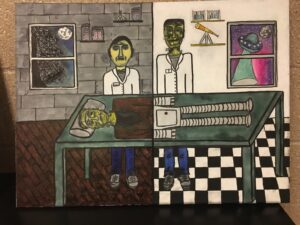
In their “Reinterpretation of Frankenstein,” Sara Bashary and Julianne Fiorino imagine a narrative in which Victor Frankenstein, rather than abandoning his creation, nurtures him and teaches him to share in his creator’s scientific pursuits. While this alternative fiction allows Bashary and Fiorino to explore the role of education in Shelley’s Frankenstein, the conceit also allows them to explore the connections between Shelley’s novel and contemporary science fiction. They imagine that a well-educated Creature, trained by Victor in the art of creation, has survived into the 21st century to carry on his maker’s work. However, rather than creating new people out of dead bodies, Creature follows the trajectory of science fiction over the past 200 years and turns to robotics or AI. In this way, the story of how Shelley’s “hideous progeny” — as she termed her novel in the 1831 introduction — went forth and prospered merges with a vision of Creature himself prospering across the ages.
Bashary and Fiorino use illustrative detail, visual allusion, and careful symbolism to depict their story in a painting. While the stone walls of Frankenstein’s lab are reminiscent of a Gothic aesthetic appropriate to the Romantic era, the sterile white walls and colorful UFO of the Creature’s lab reference Mid-century visions of the future (possibly by way of Futurama). Additionally, Victor’s jaundiced pallor provides a visual parallel to the Creature’s skin; the major distinction between the two figures are the classic neck-bolts of Boris Karloff’s 1931 performance, suggesting that the two characters are separated more by their later interpretations than by any actual difference in character.



